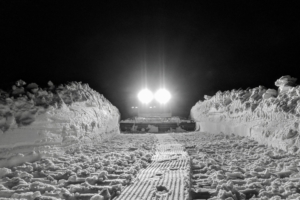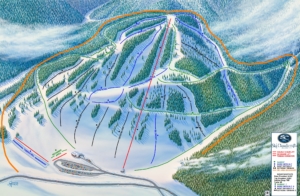SNOWMAKING
INTRODUCTION
Mother Nature does not always cooperate when it comes to natural snow for our winter recreation, the solution: snowmaking. The basic requirements for manmade snow are compressed air, water and electricity.
THE PROCESS
When you take a look around the base area you will see ponds, open top tanks, carriage snowmakers and a couple of tower snowmakers. What you don’t see is the underground network of electrical wire and pipelines that supply those snowmakers. The snowmaking pump supplies these snowmakers with up to 500 gallons per minute at 400 PSI capable of producing 300,000 gallons of water in one night. It takes approximately 200,000 gallons of water to make one acre foot of snow.
The water is combined with air from a compressor on the snowmaker into the nucleator where it forms the nucleus of a tiny snow particle. With the water near freezing temperature and air expanding at 140 PSI to normal atmospheric pressure, a snow flake is born. Dependent on temperature and humidity, the amount of water supplied to each snowmaker varies from 31 to 125 gallons per minute. The large fan propels the snowflake into the air where it freezes, going up as water, and coming down as snow onto the slope
A calculation known as the “wet-bulb temperature” is used when determining how much snow can be made. The most efficient snowmaking occurs in the low teens with low humidity. At these temperatures, an optimum amount of water can be added to the nucleus without causing any freezing problems. As temperatures and humidity rise, the amount of water needs to be decreased in order to create a dry, fluffy quality of snow. Snow can be efficiently made at a temperature and humidity factor not exceeding 100, and at temperatures up to 36 degrees Fahrenheit.
Temperature Examples…
Temp x Humidity= Wet Bulb Temperature
32F x 50% = 27
26F x 70% = 23
20F x 40% = 15
12F x 20% = 7
Snow Grooming
Powder and smooth corduroy (and we’re not talking about those sweet pants from the 90s) are arguably the two best surfaces to ski and ride on. Cutting turns on a well-groomed trail under a bluebird day is one of the best experiences for any snow sport enthusiast. What’s really going on though?
What many people don’t realize is what’s happening overnight to make ski conditions the best they can be. Mother Nature changes her mind often, changing the snow conditions with it. Warm days and cold nights make ice. Ski traffic on the mountain all day “skis” the snow down hill. Fresh powder, while a delight for snowboarders, is anything but a delight for some skiers. Even humidity changes from a storm coming in, can change perfect conditions to soft, slushy snow. This is where the snowcat comes in. It pushes the snow back up the hill, levels it out, tills up any hard snow, and leaves the nice corduroy we all love to ski.
There’s a bit more to it than meets the eye of driving a 20,000 pound tractor up and down the mountain all night. Too much down pressure on the tiller, and you create ice. Not enough down pressure, and you have too soft of snow. Just like the tale of the Three Bears, you have to meet in the middle, and find the combination that’s “just right.”
The snowcat is a large tractor (~300 HP) with a multi directional blade strong enough to rip out ice and compacted snow. It sits on two wide rubber tracks with steel cleats to bite into the snow for traction, but dispersed enough to keep from sinking in. It has a larger tiller on the back (similar to the one you use in your garden when your neighbor isn’t sneaking over taking your snap peas and peppers) but 12 feet wide, and a rubber comb leaving the corduroy pattern. It is a vital machine to the conditions we all know and expect to ski this day in age.


